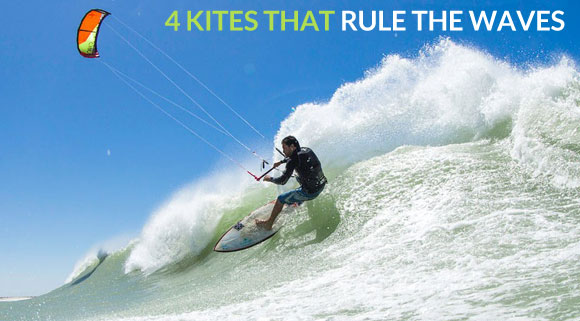
True progress occurs when gear can perform to a very specific set of demands, but is still user-friendly for all skill levels and all conditions. This is what defines a great kite for using in the waves: It excels in the surf but is still fun in flat water. Most importantly, a great wave kite is easy to use for any skill level, including beginners.
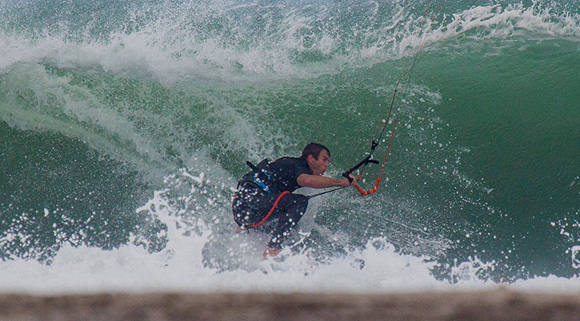
For this feature, we asked 4 kitesurfing wave addicts to break down their favorite wave kites and explain why their kites can work for any level of rider. No matter your skill level, these kites can take you from your first kiteboarding rides all the way to punting airs in the surf…
2015 Liquid Force Envy
Liquid Force and REAL Teamrider and Patagonia Ambassador,
Jason Slezak:
“There are several features on the 2015 Envy that make the kite great for wave riding, and these same features also make the kite user friendly for beginners. The 2015 Envy has a reduced leading edge diameter, allowing the kite to move more efficiently through the wind window. When I am riding waves, this efficiency allows me to move the kite to the correct position in the window regardless of wind direction, but it also helps beginners with easier power generation and flying upwind.
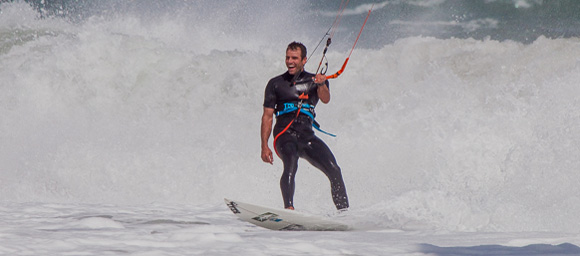
The bridle configuration on the 2015 Envy is more supportive and allows the kite to remain super stable when depowered. I like the ability to spill power out of the kite and have the kite still hold its shape while I’m riding the wave. The benefit to beginners is the same: when they need to depower, they can dump power out of the kite and the kite remains stable. The profile shape on the wingtips of the kite also create stability during flight and allows the kite to drift (remain stable in the sky) when depowered or the lines are a bit slacked. This stability is an essential feature for both advanced wave riders and beginner kiters.
The last thing I like about using the Envy in the waves is that it is lightweight. By implementing a layered frame setup we were able to reduce the overall amount of Dacron in the kite. The lighter the kite is, the better it can perform in the low-end of its recommended wind range, allowing me to fly the appropriate kite size for wave-riding and not having to rig too big. This reduction in weight will help beginners and basically anyone who uses this kite; the lighter the kite is, the more it wants to stay up in the sky and the less it wants to tumble or become unstable during flight. A great way to highlight the range of use for this kite is look at where it’s being used: It is being used to teach beginners in the REAL Lesson Center every day, but I also used it to compete in the Cape Hatteras Wave Classic kitesurfing contest. My LF teammate Brandon Scheid even dominates the wakestyle and sliders on the Envy, proving its a truly versatile design.”
CORE Riot XR3:
REAL Co-Founder Matt Nuzzo:
“One of the most impressive things about the CORE kites is the build quality. I have been sessioning the Riot XR3 in a wide range of conditions for an entire season, and they still feel like they’re almost brand new. They have a proprietary CoreTex canopy material that makes an incredibly durable kite. Whether you’re a beginner crashing your kite constantly, or an advanced wave rider who inevitably will crash his kite in the surf, durability and build quality is important for every kiteboarder.
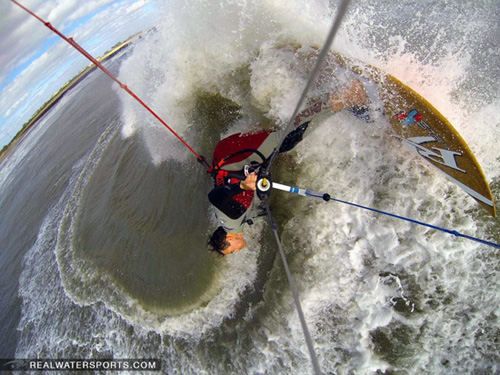
In my mind, the CORE Riot XR3 checks all the boxes for what you want in a wave kite: it is fast turning, it has adjustable bridle attachment points for customizing the ride, it has a huge wind range and it’s stable when you slack the lines. For how I ride waves, a fast turning kite is critical. With the adjustable bridle attachments you can slow the kite down a bit if you’re a beginner or make it lightning fast if you like a super fast wave kite. The adjustable bridle attachments also allow you to tune where the kite sits in the wind window, enabling you to draw great lines on the wave face regardless of the wind direction at that particular spot.
The huge wind range is a result of the kite being very stable even when fully depowered or with some slack in the lines. Even when the kite has all of the depower pulled in, you still have full steering control. If you do slack the lines enough for the kite to fall out of the sky(which happens when you wave ride), it falls in a very stable position and doesn’t begin to “tumble” out of the sky. For wave kiters this means you can really ride the wave and kill the power to the kite, then easily recover it. The net result is that you can stay properly powered on the wave.
This same stability across the wind range is exactly what a beginner kiter needs. I still do a fair amount of teaching, and I’ve found that beginners make mistakes that more experienced kiters simply can’t replicate. Whether under running the kite or riding less powered, a beginner is always going to loose line tension and make errors. The Riot XR3 stays stable in the sky during all these mistakes, which makes it not only one of my favorite kites for my personal sessions in the waves, but also my go-to kites for teaching beginners.”
2015 Naish Pivot
REAL Media’s Chris Stellato:
“When I am kitesurfing in the waves I basically require three things from my kite: I want it to go upwind and get me back to the peak for my next wave, I want it to stay in the sky if I slack the lines a bit, and I want it to relaunch if I do crash it. These same characteristics are what beginners should be looking for in a kite: it goes upwind well, it stays in the sky when you mess up, and it relaunches when you need it to.
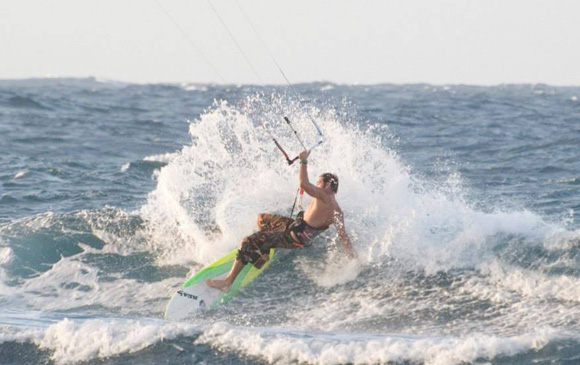
The 2015 Naish Pivot nails it on all these points and has a few other performance characteristics that make it ideal for riding in the surf. The Pivot delivers great low-end power with a “sheet-in-and-go” feeling. The medium-aspect, wing-like shape creates consistent pull and helps drive the kiter upwind in the surf, in chop, or in flat water. A kite that makes it easy to go upwind will help novice kiters achieve one of the biggest milestones in their learning process (“I finally went upwind!”). This same kite is perfect for me when I’m hammering through whitewater and against strong currents to cruise back upwind in the ocean. Even though the Pivot delivers a healthy does of power when you want it, the kite has a very light feel “in the harness” and doesn’t feel like it’s aggressively dragging me around; I always feel in control of the power. The sweep in the wingtips and overall shape of the kite also allow for effortless relaunch.
The 2015 Pivot has impressive wind range. It maintains excellent steering when fully depowered and when I completely slack the lines the kite has very stable drift. In my mind all these things are related: the kite remains stable and well behaved without a lot of line tension, allowing me to fly the kite with a ton of depower pulled in (huge wind range), and allowing me to ride a wave even if it means putting some slack in the lines (stable drift). These characteristics have obvious benefit for kiters of all abilities. A huge wind range on the kites means fewer kites in a beginner’s quiver and more safety if winds start to build during their session. The kite’s ability to remain stable and drift on slacked lines is also perfect for helping beginners through all the little mistakes they will inevitably make while learning and progressing.
One last feature worth mentioning ties in with the namesake of the kite, the Pivot. The kite stays true to its name and makes very tight-radius turns that don’t generate a lot of excessive power. The result is I have more control over which lines I’m drawing on the wave, because I can steer the kite almost anywhere I want without fear of a big burst of power that will yank me off the wave face. When beginners are progressing into carving transitions and downloops, the Pivot’s gentle turns and loops will allow them to focus on riding their board rather than bracing for a big burst of power from the kite.”
2015 BEST Cabo
REAL Co-founder Trip Forman:
“I’ve been riding “larger” surfboards with smaller kites over the last several years. When I say larger, I mean larger than what other kiters are riding, not “large” compared to what people surf on. Basically boards that are at the bottom of my volume range for normal paddle surfing (which I often use them for) and then just using a smaller kite compared to other kiters. This has several benefits, the biggest one being more of a true surfing feel on the wave without the pull of the kite. You also end up having a much wider wind range with each kite size, as the board will plane and go upwind better due to the added lift. Even though at 215lbs I’m normally one of the bigger kitesurfers on the beach, my board choices usually put me on one of the smallest kites.
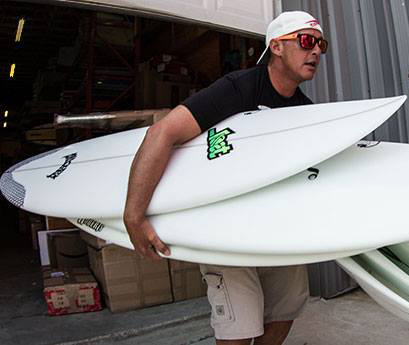
The kites I’m riding are the 2015 Best Cabos, sizes 7m, 9m and 11m, with the 9m easily covering 80% of my riding. I recently made the switch from the 2014 Best TS to the 2015 Best Cabos. The biggest improvement I noticed was the better “drifting” of the kite downwind as I rode the wave, as well as the smoother, more predictable pull through the turns. This smooth pull helps you set a much more confident bottom turn in sideshore or onshore conditions when you’re having to swing the kite a lot, plus gets you around closeout sections more easily than less predictable kites that don’t pull smoothly through the turns. The “drifting” of the kite downwind, keeps the kite ahead of you, even if you don’t turn it – and the Cabo even does that when ridden underpowered which often times I intentionally do so that when I’m on the wave, it feels more like surfing.
How does all of this translate to the wave-focused beginner using these same kites? The “drifting” of the kite indicates how stable the kite is and how resistant it is from falling out of the sky when not flown properly. In the waves we often forget to (or straight up just don’t) turn the kite a lot, often resulting in the lines going slack while our focus is on the wave. Kites that can do this and keep flying are obviously better than kites that can’t and fall from the sky. When you are a beginner or still learning, you do the same thing, either forget to turn the kite, or you don’t even know to turn the kite. A kite that keeps flying no matter what is obviously better than one that falls out of the sky. Add the fact that I’m often riding at the bottom end of the wind range of these kites and it makes this kite’s performance that much more notable. With less wind in the kite and less pull on the lines, staying flying is crucial (and a design breakthrough). Beginners are often underpowered as well and this will help them quite a bit having a kite that actually works well underpowered.
With regards to the smooth turning and pull through the turns, this helps with working on your “first bottom turns”. These first bottom turns, believe it or not, are often in flat water, as you learn toeside and heelside transitions. The steadiness of the power delivery and pull through the turn, allows you to concentrate on the turn itself, rather than fighting the kite through a turn.
I would definitely recommend the 2015 Best Cabo for anyone looking at getting kites better tuned for waves, or beginners entering the sport with waves as the primary goal. Obviously they work in flat water too, but if kiting in the waves is what you’re looking to do, the Cabo should be high on your list.”
When choosing your next kite (or your first kite!), it is important to remember the end goal and where you hope to be riding over the next couple of years. If you’re goal is to start taking sessions in the ocean and riding waves with your kitesurf board, one of these 4 kites is the perfect choice for you. Even if you’re still riding in flat water, starting to fly these kites now will make you even more prepared for your first session in the waves!
Have questions? Contact the REAL Pros for assistance and expert advice!

